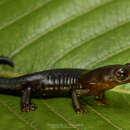Description
provided by AmphibiaWeb articles
Diagnosis: This species can be distinguished from other Colombian species of Bolitoglossa by having basal webbing with free digital tips, long body (mean adult male SVL 62.3 mm, adult female SVL 73.9 mm), lack of terminal ventrally flattened tubercles on the fingers and toes, dark gray to uniformly black body, and grooves on the ventral tips of fingers II-IV and toes II-V (Acosta and Hoyos 2006).Description: Bolitoglossa tatamae is one of the largest Colombian species of the genus Bolitoglossa. Adult male SVL is 61.1-63.5 mm (N=2); the single adult female specimen measured 73.9 mm. Tail length approximately equal to SVL. The snout is slightly rounded and longer than wide, sloping ventrolaterally and projecting in front of the upper jaw. The canthus rostralis is not prominent. Neck is distinct and has a short raised groove. The nasolabial grooves are prominent, particularly in males, and are short and curved toward the labial region. Males have a mental gland that is nearly oval-shaped, oriented transversely and prominent at the posterior. The gular fold is prominent. Adult males have 5 premaxillary teeth on the upper lip. The single adult female specimen had 28 teeth on the right maxilla, 27 on the left maxilla, and 19-20 vomerine teeth. The tongue is large and the anterior portion is rounded; it lacks a notch. Finger length in decreasing order is 3>2≥4>1. Tips of fingers are rounded. Hind limbs are short and robust. The relative length of toes in decreasing order is 3>4>2>5>1. Toes and fingers are moderately webbed. The digits are without terminal flattened tubercles. The tail has a conspicuous constriction at the base and is slightly compressed laterally. Skin is smooth. Postiliac glands are hidden but are white, moderately large, nearly oval, and oriented anteroventrally (Acosta and Hoyos 2006).In life, the dorsal surfaces are uniformly dark brown. Head, trunk, and ventral flanks are slightly paler than the dorsum. Palmar and plantar regions are dark brown. The iris is brown with small white dots. The coloration of one juvenile is very distinct from the adult; its dorsum is ochre with scattered black dots, irregular cream-colored longitudinal splotches, a white transverse interorbital stripe, and a dark brown venter (Acosta and Hoyos 2006).In preservative, the ground color is grayish brown, except for the palmar and plantar surfaces, which are pale gray (Acosta and Hoyos 2006).
- Acosta, A. R., and Hoyos, J. M. (2006). ''A new species of salamander (Caudata: Plethodontidae: Bolitoglossa) from the sub-Andean forest Western Cordillera of Colombia.'' Herpetologica, 62(3), 302-307.
- Acosta-Galvis, A. 2008. Bolitoglossa tatamae. In: IUCN 2010. IUCN Red List of Threatened Species. Version 2010.4. www.iucnredlist.org. Downloaded on 11 March 2011.
Distribution and Habitat
provided by AmphibiaWeb articles
Endemic to Colombia. Bolitoglossa tatamae is found in the Tatamá mountain rang, municipalities of Santuario and Mistrató, in the Andes of Colombia, i. It occurs at elevations of 1760-2130 m. Its habitat is humid relict sub-Andean forests with tall, dense trees, where it is commonly found on lower branches of shrubs (0.5-2 m above ground) and on leaf litter (Acosta and Hoyos 2006).
Life History, Abundance, Activity, and Special Behaviors
provided by AmphibiaWeb articles
Bolitoglossa tatamae is nocturnal (Acosta and Hoyos 2006). Reproduction may occur in October-November, since a juvenile was found in February (Acosta-Galvis 2008). It is presumed to breed by direct development.
Life History, Abundance, Activity, and Special Behaviors
provided by AmphibiaWeb articles
This species appears to be common (Acosta and Hoyos 2006) but is threatened by habitat loss from deforestation and increasing agriculture. It occurs within the Parque Nacional Natural Tatamá buffer zone, where some private reserves have been created. However, stronger park management is needed (Acosta-Galvis 2008).
Bolitoglossa tatamae: Brief Summary
provided by wikipedia EN
Bolitoglossa tatamae is a species of salamander in the family Plethodontidae.
It is endemic to Colombia. Its natural habitat includes montane humid forests. It is threatened by habitat loss.
- license
- cc-by-sa-3.0
- copyright
- Wikipedia authors and editors

